Abstract
The research focuses on the stages of appearance and development of current key word semantics in their connection with socially and politically meaningful events/situations. The key word is considered in the dynamics, which is reflected in the appearance of new connotative meanings and the merge of lexical and semantic fields. The research material includes memes, which appeared due to the development of the situation of the Corona virus infection spread. The suggested process of analysis means several stages: 1) selection and classification of the empiric material following the stages of the development of the situation; 2) the analysis of meme visual component (precedence, symbolic meanings etc.); 3) the analysis of verbal components (units of the lexical and semantic field, the basis of language play, speech tools etc.); 4) revealing the basis for social consolidation at the given stage according to the data, received at previous stages; 5) defining the connotative meanings of words included into the lexical and semantic field. The analysis of memes, which chronologically appeared during the mentioned stages, demonstrated the direct connection between the character and the variety of memes and the situation's development. The appearance and development of the key words' connotative meanings happen due to the phatic meanings, appearing within verbal and visual memes. The consolidation is provided on various foundations at various stages and by addressing the addressee's apperception base.
Keywords: Connotative meaningconsolidationcorona viruscurrent key wordmeme
Introduction
The main subject of media discussion is a socially and politically meaningful event on the agenda. Media inform about an event, estimate it, and form the behavioral motives connected with the event. The media text pathos may vary from mocking at the event and its participants to appeal to the national community's patriotic feelings – depending upon the power of influence of the event or situation on a particular community (Prieto-Ramos et al., 2020). In any case, under the influence of media in its broad sense, some common position, the direction for social consolidation, is followed.
The sign of taking certain pathos is the continuous discussion in social media of the chosen position, and after some time and correspondingly with the development of the situation, the social attitude may change. These dynamics are obvious in memes – a genre of contemporary Internet folklore, reflecting a language bearer's current worldview. In the presented research, we told the story of the appearance of the neologism
The empiric foundation of the research are the memes, which appeared in Runet at the situation development key points, connected with the Corona virus infection: 1) epidemic danger in China; 2) contamination danger coming close to borders; 3) informing about the possible ways of preventive measures; 4) WHO announcing pandemic; 5) entering the self-isolation regime; 6) correlation of the current situation with any meaning event (voting for the Constitutional amendments). As the situation with the Corona virus infection has not finished yet, this line may probably be continued. The common moment is the genre dominant of a meme – comic reconsideration of the event. The memes, reflecting the basic stages of the situation's development, are selected with the random sampling technique.
Problem Statement
The research's initial idea is that media discourse bears the current key words as the reflection of the event and its social development (Vasilieva & Prokofeva, 2015). Practically every turn of the situational development becomes a push for the appearance of a new word in the usage or the appearance of a new connotation of any word, included in the lexical and semantic field (Shcheglova, 2019), forming around the dominant word.
Research Questions
The above presented discussions allow building the basic questions of the research: 1) functioning of the current key words in media; 2) meme as the reflection of the folk language consciousness; 3) specifics of the language play in media while considering the important event.
Purpose of the Study
The purpose of the research is to demonstrate the connection of the event's social meaning with its potential for bearing the current key words. It is necessary to consider the process of appearance of the current key word in media and its semantics following the development of the socially important event.
Research Methods
The analysis of the presented empiric material demands the complex cross-disciplinary approach, so the interpretation of the examples includes the linguistic, stylistic analysis, content analysis, intentional stylistic analysis, and cultural analysis.
The process of the research means 1) selection of the empiric material following the stages of the development of the situation; 2) analysis of the visual line for revealing extra subtext meanings, causing the associative chains in the national specific world view, 3) analysis of speech component of memes, which allows clarifying the semantic overtones appearing within the interaction of visual and verbal lines, 4) defining the place of memes (Bou-Franch & Blitvich, 2019; Benavides-Vanegas, 2020; Dawkins, 1976; Dean, 2020; Kassing, 2020; Nagel, 2020; Ye Kyung Song & Crowder, 2019) in the process of reconsideration of social attitude towards the development of the situation, 5) revealing the connotative meanings of the key words, that is the center of meme creation (Baghana et al., 2019; Gualberto et al., 2020; Tanaka et al., 2017).
Findings
Stage 1. Epidemic danger coming from China
At different stages of the development of the situation, the social consolidation happens on the foundation of different interpretations, depending upon the news's attitude and the distance of the news from the national community. The initial social attitude to the epidemic danger COVID-19 was quite ironical and skeptical (Prasad, 2020; Seale et al., 2020). The media saw the appearance of neutral messages about the spread of dangerous news disease in far China. Correspondingly, the very first attempts of ironic reconsideration of the situation are connected with the associative line for spreading the infection over the state borders. This brings to life a wave of memes with the general topic «Chinese package». I.e. REGIONAL DIMENSION the social consolidation is fulfilled through preventing the infection from entering the other countries, a sort of contradiction of the world society against China (figure
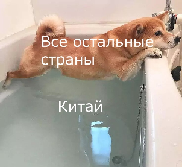
The visual line: The visual component of the meme is presented with a photo of a dog, desperately struggling against falling into water. The water, as one of the elements, in this case becomes the symbol of danger, disaster. The position of two phrases – one under the other – makes us think about the contradiction of their content.
The speech component: China as a source of danger is in the center of extreme situation, symbolized with water.
The foundation for consolidation: The verbal component, built on the contradiction, directly embodies the foundation for the social consolidation at the given stage: the world against China.
Connotation: The current presentation about the danger of the situation bears such connotative meanings of the key word Corona virus as ‘natural power’, ‘approaching danger’, ‘coming wave’.
Stage 2. Dangers coming
The second stage of considering the problem is connected with the understanding that it is inevitable to avoid the spread of the disease and the search of consolidation to struggle against in unity of actions and preventive measures. There appears a new connotation: coming unknown danger. The fear of contamination appears in the social consciousness. This stage of the development of the situation is connected with the actualization of a new phenomenon –
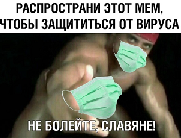
The visual line: The set example spread in the Net is based on the meme with Ricardo Milos. The man's picture, showing off at the camera, is mocked due to special gestures: dancing move is made topical. The meme author puts the protective mask in the picture and adds the wishing words
The speech component: The play form is the imperative at the top of the meme
The foundation for consolidation: Let us pay attention to the addressee's nomination in the example –
The connotation: The main connotative meaning is ‘dynamically spread virus’, ‘inevitable danger’.
Stage 3. Spread of the disease and its prevention
The problem rise creates a special atmosphere of social stress and, as a consequence, leads to a number of memes of various character. This may be characterized as a stage of fixing the existing connotative meanings and associative chains' development, connected with them. The information flow consuming comes to the stage of reconsideration of the possessed information, and the comic reconsideration of the situation means the development and the complexity of the existing images.
Let us say, there are still doubts about the danger of the disease, playing with the protective means, suggesting the protective measures etc. The development of the association is nationally specific referring to the apperceptional base of certain mentality bearers. At this stage, the national community's laughter over themselves in the aspect of stereotypes of national perception and the following attitude towards the disease and the protective measures – with accompanying motives of national pride (figure
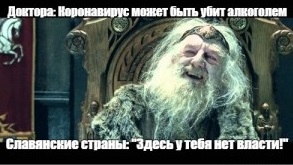
Rohan's king possessed with Sauron is depicted here. Quite an ambiguous interpretation of the Teoden's image lead to many arguments after the Tolkien's book was released as a film. The associative line of precedents, used by the Goblin (Dmitry Puchkov) while translating and sounding the film, is connected with it. Considering that Rohan is the Slavic trace in Tolkien's book, it is obvious that there are hints at the specifics of the national character: laziness, wide soul, love for alcohol (in the translator's interpretation the image of Teoden resembles the image of the first Russian president Eltsin).
The speech component is presented in the form of the anecdote dialogue. The utterance-stimulus is the information about the fact that the virus may be destroyed with alcohol (hand washing with spirit). But in the naive interpretation of medical recommendations there appears the consideration of the alcohol as a cure from all the diseases. Here comes the connection with alcoholism (stereotypical Russian sin) and the association with Teoden in Goblin's interpretation. The utterance-reaction refers to the film character's speech style: sharp contradiction between the image of Rohan's ruler from “The Lord of the Rings” and the current situation and the prevention on the agenda.
The foundation for the consolidation: The unity of efforts to struggle against the virus is revealed as the address to the national unity (Slavic countries). At this stage a typical feature of memes is the reference to the precedent of national, not the world.
The connotation: The basic connotation of the current stage is formed – ‘situation with too much social attention’. In spite of the rising fear there appears the meaning: ‘disease which may be treated in a simple way’.
Stage 4. Pandemic announcement
The next important stage in the development of the situation is the WHO announcement about the pandemic. At this moment there is the final fixing of the information about Corona virus not only in the world, but in the national agenda. This stage is characterized with the spread of the lexical and semantic field, the nucleus of which is the dominating word
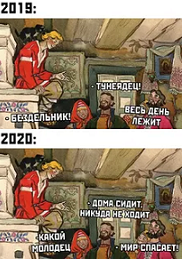
The visual line: The presented meme shows the classic illustration of the famous artist Kochergin for the fairy tale «Sivka-burka». The comic effect appears in the attempt to combine two incompatible cultures of the image – comic and style of the Russian illustration. The center of the composition is Ivan the Fool who is discussed by his older brothers with their wives.
The speech component: A special attention must be paid to the device, which lies in the meme's foundation – the classic understanding of the viewpoint in the literature terms. The same picture has a different consideration corresponding the development of the situation. So, in the speech aspect, the contradiction is presented: estimation changes from sharply negative to completely positive. The common component is a sort of an anchor – the action statement (
It becomes the foundation for consolidation: a national character is a simple man, accumulating internal power, lying on the stove and doing nothing. This line of folklore characters starts with Ilya Muromets and continues with Ivan the Fool in various stories. These meanings, ironically reconsidered, are introduced in the presented line of memes. It is clear that staying at home as a struggle against the world threat produces objections and indignation because it bears the fear of the world economy destruction. And the consolidation is very important, which addresses the folk motives – as the expression of hope for the correctness of the measures taken.
The connotation: ‘tiresome silly threat of the world range’. At this period hashtag #betterathome receives the obtrusive sounding.
Stage 5. Introduction of self-isolation regime and other measures
The main task of the next stage of the development of the situation is the adaptation to the introduced measures of freedom limitation for citizens and the further regulations from the government. Frequently the media address the following topics: school education in the distant form; problems of (small) business (with motives of death, destruction, sinking); financial support (with hints at small amount of help); sins and demerits common for humanity (laziness, heavy eating, insobriety), close communicative circle (inability to survive in the conditions of extra communication with the family) (figure
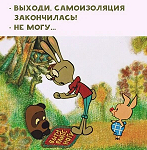
The visual line: The meme is created with the scene from the Soviet animated film story about Winnie-the-Pooh by Khitruk. The Rabbit helps Winnie get out of the hole, where he got stuck because of the food insobriety. The Rabbit's gesture is character and it symbolizes the claim to try getting out. It lies in the foundation of the secondary symbol making, which we see in the meme. By that moment, the social reflection is full, which may draw the only question, «What will happen?».
The speech component, as it often happens in memes, is a humorous dialogue between the characters. The Rabbit's gesture is added with the imperative, directly expressing the claim (
This becomes the foundation for social consolidation at the given stage. Memes are the means to express the general worry and settle down the stress that appears due to the growing disturbance.
The connotation: The self-isolation is a ‘motionless way of life, accompanied with a lot of food’.
The problem becoming topical on the agenda and its inclusion in the system of other national interests.
The problem becoming topical on the agenda leads to its consideration in various aspects: political, historical, scientific etc. This brings to life the materials that contain parallels with the past, discuss the social meaning of the event or situation, and make forecasts of its development and consequences for different spheres of social life. In memes, this stage is embodied in a combination of several politically topical questions. For example, there is a combination of Greta Thunberg's activity and the spread of Corona virus infection, meeting on the voting for RF Constitution amendments and the Corona virus consequences etc.
Conclusion
The research demonstrated that the nature and direction of memes greatly depend upon the stages of development of the event or situation and society's consideration. The significant results include the following ideas: 1) socially critical event / situation become a factor of appearance of words with a special communicative status – current key words; 2) memes as a form of modern folklore become the necessary environment for fixing the additional connotative meanings of such words; 3) connotations are formed due to the phatic meanings, included in memes due to the interaction between the picture and the speech accompaniment; 4) number of connotative meanings increases geometrically with the use of such words, the formation and further spread of lexical and semantic field around the key word dor the event / situation happens at the top of interest to the situation; 5) consolidation happens on different stages of the development of the situation, its foundations being different and responding to the current state of the world view; 6) consolidation happens with visual and verbal components due to the address to the apperceptional base of the addressee.
Acknowledgments
The reported study was funded by RFBR and ANO EISR, project number 20-011-31481.
References
- Baghana, J., Blazhevich, Y. S., Prokhorova, O. N., Kuslova, E. L., & Yakovleva, E. S. (2019). On the Problem of Lexical Semantic Change. Journal of Research in Applied Linguistics, 10(SP), 320-326.
- Benavides-Vanegas, F. S. (2020). Emoticons, memes and cyberbullying: gender equality in Colombia. Social semiotics, 30(3), 328-343.
- Bou-Franch, P., & Blitvich, P. G.-C. (2019). Analyzing Digital Discourse. New Insights and Future Directions. London: Palgrave Macmillan.
- Dawkins, R. (1976). The Selfish Gene. Oxford: Oxford University Press.
- Dean, R. (2020). Durrr-dur-dur-dur-dur-durrrr-durrrrrr: more than just White Stripes. Sport in society, 1-14.
- Gualberto, C., dos Santos, Z. B., & Meira, A. C. (2020). Multimodal metaphors: from language as a condition to text to the notion of texture as a meaning-making semiotic resource. Revista de estudos da linguagem, 28(2), 893-915.
- Kassing, J. W. (2020). Messi hanging laundry at the Bernabeu: The production and consumption of Internet sports memes as trash talk. Discourse context & Media, 34, 100320.
- Nagel, K. W. (2020). Make America Meme Again: The Rhetoric of the Alt-Right. Quarterly journal of speech, 106(2), 216-219.
- Prasad, A. (2020). The organization of ideological discourse in times of unexpected crisis: Explaining how COVID-19 is exploited by populist leaders. Leadership, 16(3), 294-302.
- Prieto-Ramos, F., Pei, J., & Cheng, L. (2020). Institutional and news media denominations of COVID-19 and its causative virus: Between naming policies and naming politics. Discourse & Communication, 14, 635-652. https://doi.org/10.1177/175048132093846
- Seale, H., Heywood, A. E., Leask, J., Sheel, M., Thomas, S., Durrheim, D. N., Bolsewicz, K., & Kaur, R. (2020). COVID-19 is rapidly changing: Examining public perceptions and behaviors in response to this evolving pandemic. Plos one, 15, 6.
- Shcheglova, Е. А. (2019). The Lexical Originality of a Literary Work: On the Technique of Analysis (A Case Study of Ivan Goncharov’s Book of Travel Essays The Frigate “Pallada”). Tomsk State University Journal, 442, 61-68.
- Tanaka, R., Mineshima, K., & Bekki, D. (2017). Factivity and presupposition in Dependent Type Semantics. Journal of Language Modelling, 5(2), 385-420. DOI:
- Vasilieva, V., & Prokofeva, N. (2015). Slang Toponyms and Newsmakers’ Nicknames as a Communicative Contact and Indicator of Comic Culture in the Modern Russian Journalism. International Review of Management and Marketing, 5(5), 1-10.
- Ye Kyung Song, & Crowder, J. (2019). Memes in medical education: Making sense of professional authority. Medical Anthropology Theory, 6(2), 102-119.
Copyright information

This work is licensed under a Creative Commons Attribution-NonCommercial-NoDerivatives 4.0 International License.
About this article
Publication Date
16 April 2021
Article Doi
eBook ISBN
978-1-80296-104-1
Publisher
European Publisher
Volume
105
Print ISBN (optional)
-
Edition Number
1st Edition
Pages
1-1250
Subjects
Sustainable Development, Socio-Economic Systems, Competitiveness, Economy of Region, Human Development
Cite this article as:
Prokofeva, N., & Shcheglova, E. (2021). Socially Meaning Events In Memes: Potential For Social Consolidation. In E. Popov, V. Barkhatov, V. D. Pham, & D. Pletnev (Eds.), Competitiveness and the Development of Socio-Economic Systems, vol 105. European Proceedings of Social and Behavioural Sciences (pp. 716-725). European Publisher. https://doi.org/10.15405/epsbs.2021.04.76

